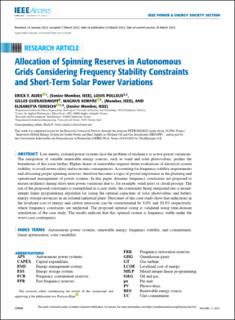| dc.contributor.author | Alves, Erick Fernando | |
| dc.contributor.author | Polleux, Louis | |
| dc.contributor.author | Guerassimoff, Gilles | |
| dc.contributor.author | Korpås, Magnus | |
| dc.contributor.author | Tedeschi, Elisabetta | |
| dc.date.accessioned | 2023-10-31T07:46:33Z | |
| dc.date.available | 2023-10-31T07:46:33Z | |
| dc.date.created | 2023-04-28T11:02:30Z | |
| dc.date.issued | 2023 | |
| dc.identifier.citation | IEEE Access. 2023, 11 29896-29908. | en_US |
| dc.identifier.issn | 2169-3536 | |
| dc.identifier.uri | https://hdl.handle.net/11250/3099587 | |
| dc.description.abstract | Low-inertia, isolated power systems face the problem of resiliency to active power variations. The integration of variable renewable energy sources, such as wind and solar photovoltaic, pushes the boundaries of this issue further. Higher shares of renewables requires better evaluations of electrical system stability, to avoid severe safety and economic consequences. Accounting for frequency stability requirements and allocating proper spinning reserves, therefore becomes a topic of pivotal importance in the planning and operational management of power systems. In this paper, dynamic frequency constraints are proposed to ensure resiliency during short-term power variations due to, for example, wind gusts or cloud passage. The use of the proposed constraints is exemplified in a case study, the constraints being integrated into a mixed-integer linear programming algorithm for sizing the optimal capacities of solar photovoltaic and battery energy storage resources in an isolated industrial plant. Outcomes of this case study show that reductions in the levelized cost of energy and carbon emissions can be overestimated by 8.0% and 10.8% respectively, where frequency constraints are neglected. The proposed optimal sizing is validated using time-domain simulations of the case study. The results indicate that this optimal system is frequency stable under the worst-case contingency. | en_US |
| dc.language.iso | eng | en_US |
| dc.publisher | IEEE | en_US |
| dc.rights | Navngivelse 4.0 Internasjonal | * |
| dc.rights.uri | http://creativecommons.org/licenses/by/4.0/deed.no | * |
| dc.title | Allocation of Spinning Reserves in Autonomous Grids Considering Frequency Stability Constraints and Short-Term Solar Power Variations | en_US |
| dc.title.alternative | Allocation of Spinning Reserves in Autonomous Grids Considering Frequency Stability Constraints and Short-Term Solar Power Variations | en_US |
| dc.type | Peer reviewed | en_US |
| dc.type | Journal article | en_US |
| dc.description.version | publishedVersion | en_US |
| dc.source.pagenumber | 29896-29908 | en_US |
| dc.source.volume | 11 | en_US |
| dc.source.journal | IEEE Access | en_US |
| dc.identifier.doi | 10.1109/ACCESS.2023.3261805 | |
| dc.identifier.cristin | 2144132 | |
| cristin.ispublished | true | |
| cristin.fulltext | original | |
| cristin.qualitycode | 1 | |

